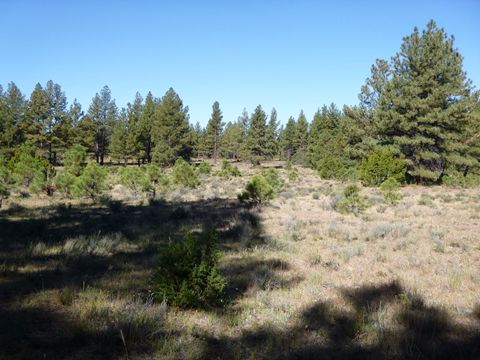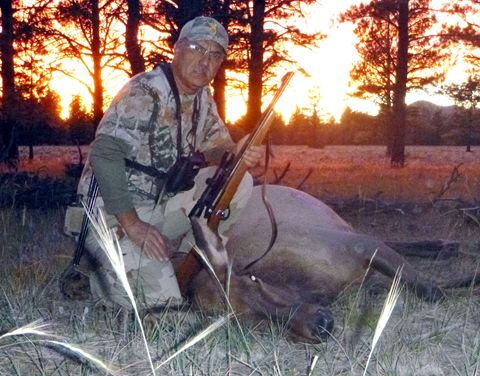
| Articles | Documents | Equipment | Events | Links | Membership | Miscellaneous | Scrapbook | Targets | What's New |
| 50th Anniversary Elk | November 2014 | |||||||
| Dan Martinez
| ||||||||
|
My son Ben and I were drawn for a spring turkey hunt north of Flagstaff
in 2013. We didn’t find any of the big birds on that hunt, but we found
and sat at a water hole that was visited nearly every day by elk. There
was a brush blind at the base of a tree where we both had close encounters
with elk. And when I say close, I mean rock throwing distance.
When the next opportunity came along to apply for an elk hunt, guess
which area I put down as my number one choice? I put down a bull hunt
for first choice and a cow hunt for second choice. I was drawn for the
cow hunt for the 2014 season.
When planning a hunt, it’s always part of the fun to go through the gun
safe to decide which of the various firesticks will get to go. At first,
my plan was to hunt with my Lone Eagle handgun in .44 Magnum. If the elk
were again walking by that close, a .44 mag should do the job. Plus,
being able to say that I had taken an elk with a handgun should be worth
quite a few brag points!
Sanity eventually overtook me when a new plan was hatched. Earlier this
year, I wrote about acquiring a second
Remington Model 600 carbine. I have owned one in caliber 6mm Remington
for a number of years, but the new one was chambered in .308 Winchester.
I was drawn both for elk and deer this year. Wouldn’t it be cool to take
an elk with the .308, and a deer with the 6mm, in the same year? — and that
year happening to be the 50th anniversary year of the Remington Model 600?
Yeah!
Speaking of Ben, he has been up in Corvallis, Oregon for the last year at
Oregon State University. The plan was that he was working on his PhD in
Chemistry. Well that plan has been aborted and he was in the process of
moving back home. He arrived home with a truck and trailer full of stuff
on the day that I went north to set up camp.
I arrived as early as I could on Thursday morning, the day before the
opening day of my hunt. I wanted to get my pick of camp spots. The spot
I wanted was only a quarter mile from the water hole. But when I arrived
I found another hunter had set up, not there, but only about 200 yards
away. I didn’t want to camp right on top of someone else, so I went to
my alternate spot about a mile from the hole, but still a very nice spot.
However, when I checked out the waterhole, I found that now it was just a
mud hole. My Plan A, to set up a pop-up blind at the waterhole and sit
in-wait for elk to come in, had just blown up.
The waterhole sits between two low hills. From what I knew, the elk hung
around in the hills most of the day, then came down to drink when they got
thirsty. Not knowing what else to do, my Plan B for Friday morning was to
stalk the hills hoping to see them before they saw me.
From the hole, I slowly stalked up to the top of the west hill. From there,
I heard a lilting bugle off to my north. Awesome! It was early enough in
October to still catch the tail end of the rut. Now I knew that despite no
water in the hole, the elk were still around. I headed that way.
After a few minutes of slow and quiet travel, I spotted the bull. He was
a nice shooter bull, at least a 5x5, maybe larger. He was filtering
through the trees about 80 yards away. I don’t think that he spotted me,
but he was on his way heading westward with a purpose. Soon, he had left the
scene. It was only him, no cows in tow. Now that’s the way to start a hunt –
with plenty of promise!
Later that morning, I had crossed over the draw that separates the two hills.
I was making my way toward the top of the east hill when I heard a great
cracking of branches ahead of me. I had busted another elk out of bed. I
caught a glimpse of tan elk flank as it ran away, but I was not able to make
out whether the elk wore headgear. More encouragement!
I went back to camp for lunch, then came back to explore more of the west hill
for the evening’s hunt, but I had no more elk sightings on opening day.
On Saturday morning I came back again to explore more of the east hill. I had
a good hike, and learned the country a little better, but had no elk sightings
on my second morning. Back to camp for lunch.
Besides, I was expecting a visitor. I had not seen Ben since the Christmas
holidays. He was coming up to join me on the hunt for the weekend. Around
about one o’clock he came rolling in. Ben would hunt with me for Saturday
afternoon and all day Sunday. He had to get back home after dinner on Sunday
night, because Monday he was expecting the rest of his stuff to arrive from
Oregon in one of those moving pods.
After setting up a small tent, Ben joined me for a ride in the Polaris Ranger.
I wanted to check out an area where I had seen elk while on a deer hunt with
Ray Cernansky a number of years ago. At the time, I had walked in to the area
from the main road, but now I knew how to access the area on a legal quad road.
Let me talk about that for a moment. In recent years, most Arizona National
Forests have adopted the “MVUM” travel management concept. MVUM stands for
Motor Vehicle Use Map. Though there may be hundreds of officially signed roads
throughout the forest, they are now considered as closed to motor vehicle
travel unless they show up on the official MVUM. This is a pain in the ass.
Not only because a lot of perfectly good roads are no longer legal to ride, but
because of the camping restrictions that go along with this.
It used to be that you could camp wherever you wanted to. Now, only certain
roads are designated as “dispersed camping corridors”. On the Coconino Forest,
you can take your vehicle up to 300 feet from the edge of one of these
designated roads.
You can still camp off of any officially open road, but if it is not marked as
a dispersed camping corridor, then you have to park no more than 30 feet from
the edge of the road!
From what I saw, either most people don’t know about these new restrictions,
or they are ignoring them. I believe that the Game & Fish Department is
choosing not to enforce the camping restrictions, so that leaves enforcement
up to National Forest rangers, of which there are not very many. Take that
for what it’s worth, in making your own decision about whether to abide by
these untenable new restrictions. Now back to the hunt …
Officially, this road is designated as open to any vehicle, not just to quads.
But due to deep rutting and off-camber sections, clearly a small vehicle such as
a quad or UTV would be the vehicle of choice for this trail. It was a lot of
fun on the Polaris Ranger.
We proceeded on to find the end of the road. We stopped there for a little
sight-seeing, but since this was very open country, it did not seem likely elk
country.
Before breaking out into the open, we passed an intersection with another road,
one that was not shown as open on the MVUM. We headed back to this intersection
with the plan to walk this other road.
Not long after starting our walk, Ben again spotted game. Elk! It was another
nice bull. I put a tree between myself and his eyes as I headed toward him.
That didn’t much fool him. He spooked and ran.
We continued walking on down the road until we found ourselves at a nice park.
We decided to just sit until dark at the edge and wait to see if anything showed
up. Nothing did, but it gave Ben and I a chance to catch up, for me to learn of
his future plans now.
That night in camp we debated about where to go in the morning. The area we rode
into was nice, definitely worth further exploration. From our one ride into it,
it appeared that no one else was hunting the area. But in the end, we decided to
head back to the hills surrounding the mud hole tank, but this time, to drive even
further past the water hole, about another mile.
So that’s where the first light of Sunday morning found us. I was initially
planning to head eastward, toward the north foot-slope of the west hill. That was
the area where I heard, and saw that first bull elk on opening morning. But after
shutting off the Ranger and gathering our packs, we heard some distant bugling to
the southwest of us.
So we headed off that way, into forested flats. The bugling was very intermittent,
and still distant, so we didn’t have a clear beacon to guide us toward the elk. We
wandered this way and that while heading generally westward. Eventually we hit a
two-track trail that we didn’t know about. The two-track was on a small rise that
was populated with a stand of young Christmas tree sized pines. We followed the
trail south for a ways until instinct or something else told us to get off the trail
and continue going west.
After walking about 75 yards west off the trail, the land dipped downward again into
thicker, more mature forest, and at the edge is where I spotted the tan side of an
elk body another 70 yards away. I dropped down to my knee and threw the rifle up to
my shoulder. Another bull!
In time it became apparent that there were more elk there than just the single bull.
It was a herd of at least 10 elk. I tried to move into a position to get clear sight
of a cow. But somehow, they sensed us and started moving out. We gave pursuit, but
at the same time tried to remain as least disturbing as possible. We lost sight of
them.
We followed in the direction that we thought they were headed. This eventually
brought us to the edge of a large park. There was no sign of them as we scanned
the far edges of the park. Where did they go?
Again going on instinct, I decided to cross the open park to the opposite edge where
there was another line of trees on a rise in the land. When we reached the top of
the rise, we could see how far west we had come. The land to the west was clear of
trees. Not far from us was a utility line road, and beyond that, cars rushed by on
the main highway. The highway is also the western boundary of my hunt unit. There
was no sign of the elk.
I was getting hungry for the breakfast bagel I carried in my pack. So I decided that
we should head back to the park, sit down near the top of the rise for better seeing,
and enjoy our breakfast. But right after talking off my pack, we heard another bugle
close by to our south. “Don’t they know that I was just getting comfortable?” I said
to Ben. “OK, let’s go.” I had just got my pack back on when we spotted elk running
right at us from out of the trees! I got down on one knee, and slipped off the safety.
There was a cow and two calves, followed by a bull. As they came in, they spotted us
and veered off. They were moving so fast that I was not able to get my crosshairs on
the cow before they disappeared! Wow! We tried to follow them up, but again they
gave us the slip.
From there, we ended up following some more bugles back toward the east, back toward
where the Ranger was parked. We found ourselves at another semi-open area that had a
nice comfortable log from where we could sit, look over some nice country, and finally
have breakfast. We sat there for a good while, but with no more action.
We did have one more elk encounter later in the morning. After we got tired of sitting,
we stalked this opening northward. We eventually reached a thicket of tall young tress
of about 6” to 8” diameter. I pulled the rifle off my shoulder and held it in my hands.
I dialed the scope’s power ring down to 3x. As we pushed our way deeper into these trees,
there came the sound of crashing branches. We had just jumped yet another bull out of his
bed! He was gone in a flash, but as we approached his bed, we could definitely smell the
rich aroma of elk.
What a morning! We bumped into elk at almost every turn. Bulls, bulls, bulls! Somehow,
the cows were staying more elusive than the bulls on this hunt.
After lunch we came back into this area, but this time we accessed it from the utility
line road, instead of the road past the waterhole. We found where the two-track trail
intersected the utility line road, but since the two-track was not on the MVUM, we
parked the Ranger at the intersection and walked into the woods heading toward the
various elk-sighting GPS waypoints that we laid down that morning.
A few minutes later we spotted a bull, with antlers held high over his back, trotting away
from us through the trees. I laid down another GPS waypoint, this one I named, “ELKLAND”.
We spent about another hour, circling Elkland, hoping to find another but with no luck.
I decided that we should just take a seat and watch over the park until sundown.
We had chosen some logs to sit against on the opposite side of the park from where we
had log-sat in the morning. After all, the sun was now coming from the opposite direction,
and we wanted to wait in the shadows.
Then, just before sundown, we spotted an elk body, not 40 yards from us, but shielded by
a thick screen of cover. I got my rifle up on the shooting sticks, and snicked-off the
safety, hoping that the elk would walk into the nearby opening. We waited, and waited,
then Ben said that the elk was leaving the scene – in the wrong direction!
I got up and slowly stalked to the opening and peeked around the corner. Nothing. I
cautiously stalked around the corner for maybe 50 yards, but never caught sight of the
elk that was just there a moment ago. Sheesh!
I walked back to Ben sitting at the logs. We remained sitting for a few more minutes,
but as the sun was now down, we were quickly losing the light. Just behind us was the
two track trail which led directly back to the Ranger parked about .4 miles away. So
we gathered up our stuff and hit the trail.
From where we sat, the trail breaks out into flat treeless ground in about one-tenth
of a mile. The forest edge recedes to our left eventually reaching about 200 yards
away as we made our way toward the Polaris. I noticed Ben looking off to the edge of
the woods. I saw what he was looking at, a large brown shape. He says, “I think it’s
just some wood.” I had pulled out the binos and said, “No, it’s a bull.” I had
spotted some sticks behind the elk’s head, but as I continued to watch, it seemed that
the sticks were not attached to the animal! “No, it’s a cow!”
Ben was carrying my shooting sticks for me. I got down on my knee and he handed them
to me. I focused on the animal through the scope, but I saw that there were some
green branches covering the vitals. I turned my head to Ben to tell him why I was
holding my fire. I quickly turned back to the scope to see the animal start to move
which cleared the chest for a shot, but for just one second before the animal moved
off into the forest.
Dang! Yet another missed opportunity! I later told Ben that due to the darkness and
the distance, I really wasn’t 100% sure that it was a cow. Taking that shot would
have been risky. Even if the animal would have held in the clear for a longer
opportunity, I would have taken the time to really study it’s head for (lack of) antlers.
That evening, it was time to say goodbye to Ben. He ate a quick dinner with me in
camp before leaving. After all the elk we had seen throughout the day, I told him
that I felt pretty confident that tomorrow would be the day. He told me to give him
a call if I needed help with elk retrieval and he would come back.
Alone again, I spent the next morning and the next afternoon haunting Elkland without
seeing any elk, despite the confidence I had expressed to Ben. As the afternoon wore
on without any sightings, I desperately sped up my wanderings hoping to stumble into a
shooter. I figured that the more ground I covered, the better my chances.
But sunset had once again come to Elkland. It was time to hit the trail back to the
Ranger. But remembering the elk sighting at last light that Ben and I had 24 hours
ago, I decided that instead of walking the trail across open ground, this time I would
skirt the edge of the woods, hoping that lightning would strike twice. And it did.
In almost the same place that we saw yesterday’s elk, I spied at least two grazing out
in the open country about 50 yards from the edge of the woods. I still had a number
of small trees between me and them. I scurried behind one tree to the next as I made
my approach. I could hear the sound of my own heartbeat rising up in my ears.
From behind a bushy juniper, I could make out a magnificent bull elk. Somehow, he made
me, even though I was fully behind the juniper and I could see him only through a
screen of branches. I froze until he went back to grazing, then I made my move to the
next cover tree.
My new position revealed a cow about 120 yards out. The bull had again focused his
attention on me as I brought the rifle up and aimed it at the cow from a kneeling
position. I had collapsible shooting sticks tucked into my belt, but instead of
fiddling with them, I made the decision to trust my natural marksmanship.
The moment had come. BOOM! The cow moved off some, but was not down. Work the
bolt – BOOM! At this point the cow moved out of my sight. I scurried out from
behind the trees and again took a knee. I was not sure if the cow I now saw was
the same one that took my bullets, so I waited.
But the story does not end here. With only about 10 minutes of light left, I
hurriedly got out the camera to get a trophy shot. My mind was reeling, thinking
about the work that was now before me, and me alone, in the dark.
The Ranger was only .15 miles away. Thankfully, the travel management rules allow
you to take one vehicle cross country for elk retrieval. That’s not allowed for
any other game, just elk. So I took a quick GPS fix of the elk because I knew that
by the time I would be driving back, total darkness would be here and the GPS arrow
would allow me to go straight to the elk.
Before the hunt, I had installed some new lights on the back of the Ranger. The
Ranger has never had backup lights. These new lights are not exactly backup lights,
because they don’t come on when you shift into reverse. You can turn them on at
any time with a switch on the dash. So now it was time to put them to good use.
I backed the Ranger toward the elk with the lights shining brightly. I left the
Ranger idling while working on the elk.
This is my third cow elk, our family’s fifth. This one may be our largest. Every
time I remove the innards of an elk, I am amazed at the amount of STUFF that comes
out of the body cavity. It usually takes me from 45 minutes to an hour to get this
task done.
I have a system to winch an animal into the bed of the Ranger using a block and
tackle. The last time I tried it, it went very smoothly. I have a couple of
straps that make a harness around the elk. I attach the block and tackle to the
top of the Ranger’s roll cage. The Ranger’s bed tilts down so that the open tailgate
is within a foot of the ground. I then tie the pulling end of the block and tackle
to a tree behind the elk. By slowly driving forward, the animal will be pulled into
the bed – when all goes well.
This time it didn’t. As I drove forward, the pulling end of the line snapped. The
elk was still on the ground. Ugh. My only option now was to quarter the elk, right
there on the ground.
The Ranger has a “trunk”, a large plastic box that is more or less permanently bolted
into the Ranger’s bed. In there I carry certain supplies, tools, and spare parts.
It is also where my backpack rides on the way to the hunting grounds. The only time
the box comes out is when I need to winch an elk into the bed. One of the things I
carry in the box is a tarp just for times like this, to protect game meat from road
dust. I spread out the tarp in the bed as I started cutting meat from the carcass.
After about another hour-and-a-half, I had the four quarters plus the head and neck
in the bed of the Ranger and I had tied the tarp over and around the meat. I started
up the Ranger one more time and turned on all the lights as I tidied up the site. I
was going to leave the trunk here overnight, planning to retrieve it the next day.
So whatever gear was not going back to camp with me tonight went into the trunk.
I hopped into the Ranger and turned off the rear lights, but I noticed that the
various dash lights and the headlights sure seemed dim. I gave the gas pedal a light
push to get going, and the engine stalled. Guess what? The battery was so worn down
that there wasn’t enough juice left to crank the starter! I guess idling the engine
was not enough to keep the battery charged while those bright lights were blazing.
I just hung my head on the steering wheel.
Sometimes, if you let the battery sit, enough juice will self-recover to allow the
motor to crank. I tried that three times. No dice. So it looks like I’m walking.
Camp is two miles away. I did have a headlamp, which I was using during the elk
work, in addition to the Ranger lights. But how much power remained in my headlamp?
Enough.
I finally got to camp about 10 pm. I didn’t sleep well that night, especially when
I heard the coyotes start howling all around me. What would I find when I got back
to the Ranger in the morning? Would my meat still be OK?
I did have a solution for the Ranger’s problem. I was experimenting for the first
time with a new solar panel setup for camping. I had brought along one of our
electric trap batteries for storing the solar power generated during the daylight
hours. Sure, I could have drove the truck right up to the Ranger and jumped it
directly, but I wanted to be a good do-bee and not take a second vehicle to the
elk recovery site. I could drive the truck legally to where I originally parked
the Ranger and walk the trap battery to the Ranger.
So just after sunup, I reached the intersection of the utility line road and the
two-track trail with truck and trailer. It was easier to drive around from the
main highway, instead of taking the direct route from camp along the utility line
road. I turned the truck to face back toward the highway, and dropped the tailgate
of the trailer.
I made the short hike to the Ranger with the trap battery strapped to a pack frame.
Thankfully, the wild dogs did not find the elk overnight. The meat was fine.
I jumped the trap battery to the Ranger’s battery and waited for a couple minutes
for a small charge to be transferred. The Ranger started up, no problem. For the
short trip to the trailer, I put the trunk on top of the meat in the bed, made sure
that I had everything, and putted over to the truck. After moving the trunk into
the truck’s bed, and making several other transfers of equipment from the Ranger to
the truck, I drove up into the trailer, then tied the Ranger down for transport.
Now it’s off to the meat processor’s in Flagstaff.
What a great hunt. I saw elk every day, opportunities galore. I got to spend some
quality time with my son, and even suffered some setbacks which cemented a memorable
adventure. Who knows when this M600 last took game? Will his 6mm brother also get
a deer this year?
| ||||||||
| If you enjoyed this story, or found it useful, please consider clicking here to join the NRA at a discount of $15 off the normal membership cost. You will be supporting both this website and adding your voice in support of the Second Amendment. Thank you very much. |
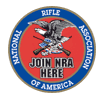
|

|
|
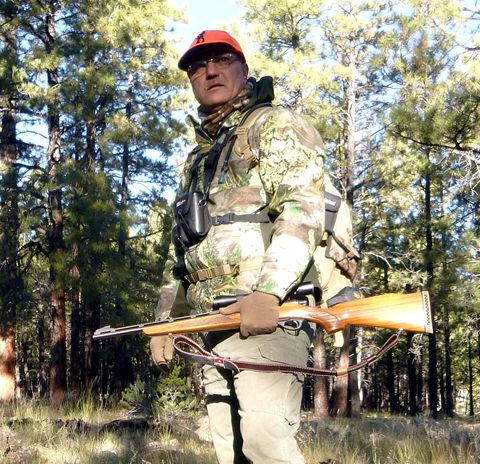
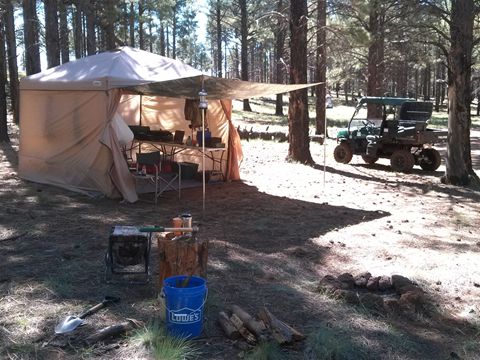
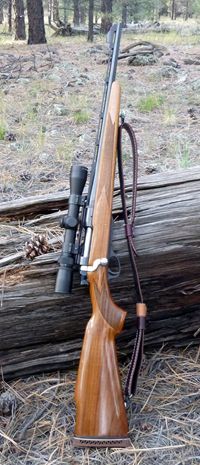
 This is the rifle, excuse me Remington, carbine that I found on Backpage.com
earlier this year. It was made in September of 1965, so this particular sample
is only 49 years old, not 50. But it has made it down through the years in
beautiful shape. It looks practically brand new.
This is the rifle, excuse me Remington, carbine that I found on Backpage.com
earlier this year. It was made in September of 1965, so this particular sample
is only 49 years old, not 50. But it has made it down through the years in
beautiful shape. It looks practically brand new.
